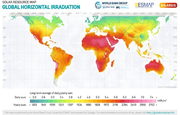Knowledge fuels change - Support energypedia!
For over 10 years, energypedia has been connecting energy experts around the world — helping them share knowledge, learn from each other, and accelerate the global energy transition.
Today, we ask for your support to keep this platform free and accessible to all.
Even a small contribution makes a big difference! If just 10–20% of our 60,000+ monthly visitors donated the equivalent of a cup of coffee — €5 — Energypedia would be fully funded for a whole year.
Is the knowledge you’ve gained through Energypedia this year worth €5 or more?
Your donation keeps the platform running, helps us create new knowledge products, and contributes directly to achieving SDG 7.
Thank you for your support, your donation, big or small, truly matters!
SPIS Toolbox - Solar Irradiation

| ►Back to the Start Page | ►Back to the Module Page | ►Go to the Next Chapter |
Solar Irradiation
Solar irradiation is a key factor in gauging the market potential of SPIS within a region. It refers to the amount of energy incident per unit area on the earth’s surface in units of watts hours per square meter. PV systems use Global Horizontal Irradiation (GHI) which is the total amount of radiation received from above by a horizontal surface. GHI consists of both Direct Normal Irradiation (DNI) – the amount of solar radiation received per unit area by a surface that is always held perpendicular to the incoming rays and; Diffuse Horizonal Irradiation (DHI) – the amount of radiation received per unit area by a surface that does not arrive on a direct path from the sun, but has been scattered by molecules and particles in the atmosphere.
Solar radiation can be categorized into four classes: levels less than 2.6kWh/m2 are classified as low solar radiation while solar irradiance between 2.6-3kWh/m2 is moderate solar radiation; irradiance of between 3-4kWh/m2 is high solar radiation and irradiance higher than 4kWh/m2 is very high radiation. It is important to note that the classification is used for purposes of distinguishing the efficiency of systems as advances in solar technologies have allowed for the set-up of systems in almost all areas that receive radiation. In areas of low radiation, system efficiency will be compromised due to lower panel output. Additionally, set up of solar panels in regions of low solar radiation could lead to high set up costs resulting from the use of a greater number of panels to generate the same output as regions with higher insolation. It is therefore noted that, because of technological advances, solar irradiation is more of an economic consideration than a question of technical feasibility.
Outcome/Product
- Classification of regions based on GHI or PV system output
- Identification of optimal sites for SPIS
Data Requirement
- Global horizontal irradiation data
People/Stakeholders
- Solar PV system installers
- Meteorological service providers
- Solar equipment suppliers
Important Issues
- There are various other factors that affect the functionality of a PV system in addition to solar irradiance. Two of the most important include temperature and aspect which are further expounded on in the ambient temperature and topography sections of the module.




















